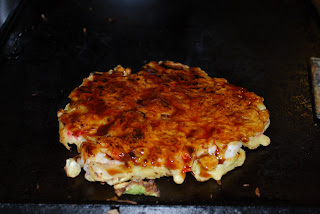

Named after a district in Tokyo (Roppongi 六本木) that is popular with western visitors to Japan. This is often where other expats new to Japan come to have fun and get tips on what to see and do in Japan. With that in mind, I hope to offer tips/comments/recommendations on a wide array of Japan items for other people travelling to Japan: sightseeing spots (main stream and off the beaten path spots) around Japan, fun cafes, hotels, restaurants, clubs, music, travel books, language tapes, etc.



 When you enter the entire staff screams out in unison welcoming you to the restaurant. It is wonderful and certainly different from other spots you may have eaten at previously.
When you enter the entire staff screams out in unison welcoming you to the restaurant. It is wonderful and certainly different from other spots you may have eaten at previously.












 After the climb, you can take a much easier route back down the mountain to the 5th station, this is a winding path, much easier than the way up.
After the climb, you can take a much easier route back down the mountain to the 5th station, this is a winding path, much easier than the way up.





Chicago, Madrid, and Rio de Janeiro are the other 3 candidates still in the running; however, Tokyo and Madrid are widely perceived as being the two leading candidates. The fact that Olympic Games have recently been held in Asia and Europe might give Rio the edge. Ultimately time will tell when on October 2, 2009, the 2016 Games host city will be announced.
Tokyo's logo for the 2016 Games is a musubi (むすび), a traditional, mystical knot which signifies times of blessing, and this blessing appears to make use of all of the Olympic colors.
Whatever the outcome, whichever city hosts the Olympics in 2016...here's to the spirit of the Beijing Summer Olympic Games starting tonight and the embodiment of the motto of the Olympic Games:
Citius, Altius, Fortius...... "Faster, Higher, Stronger"....
Let's try to strive for these goals in our own lives each and every day.
All the best....Mark




















In this district, you can also find the Tokyo Stock Exchange (東京証券取引所) - one of the top 5 exchanges in the world - which has a visitors observation deck and an exhibit comparing this exchange to other major exchanges around the world.
Also, in this area are the Kite Museum, the Bridgestone Museum of Art, the Pokemon Center, as well as the National Film Center. So put on a comfortable pair of sneakers and explore this often overlooked neighborhood.
All the best.....Mark


There are of course numerous Excelsior Caffes located throughout Tokyo and Japan all offering similar coffees, blended drinks. More details, additional menu items and caffe locations can be found on their web site http://www.excelsiorcaffe.com/ - hope you enjoy it.
All the best....Mark